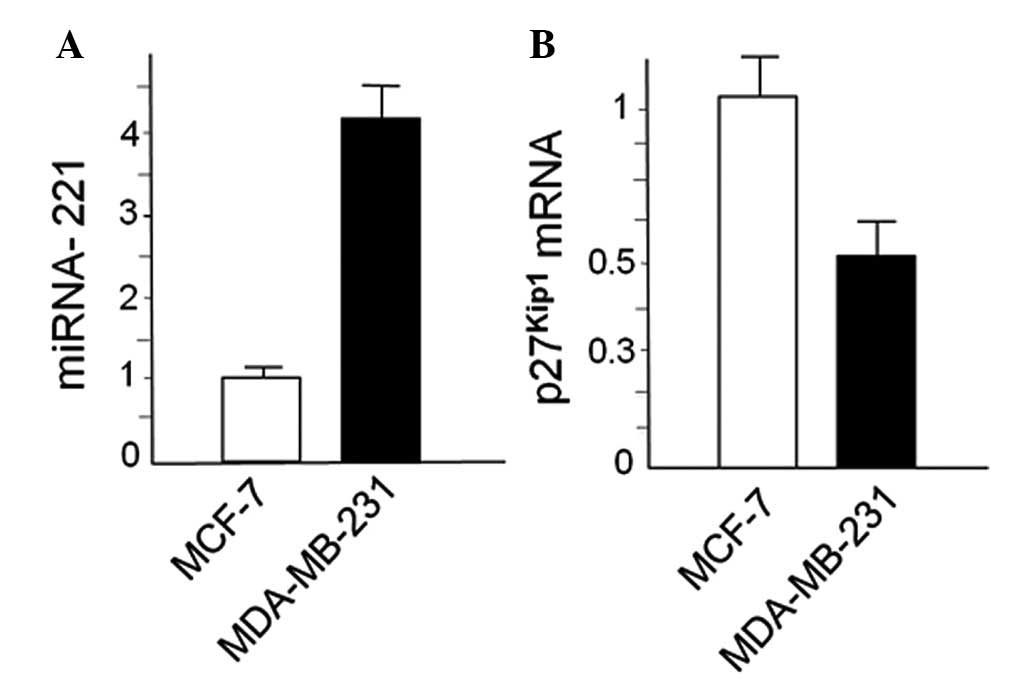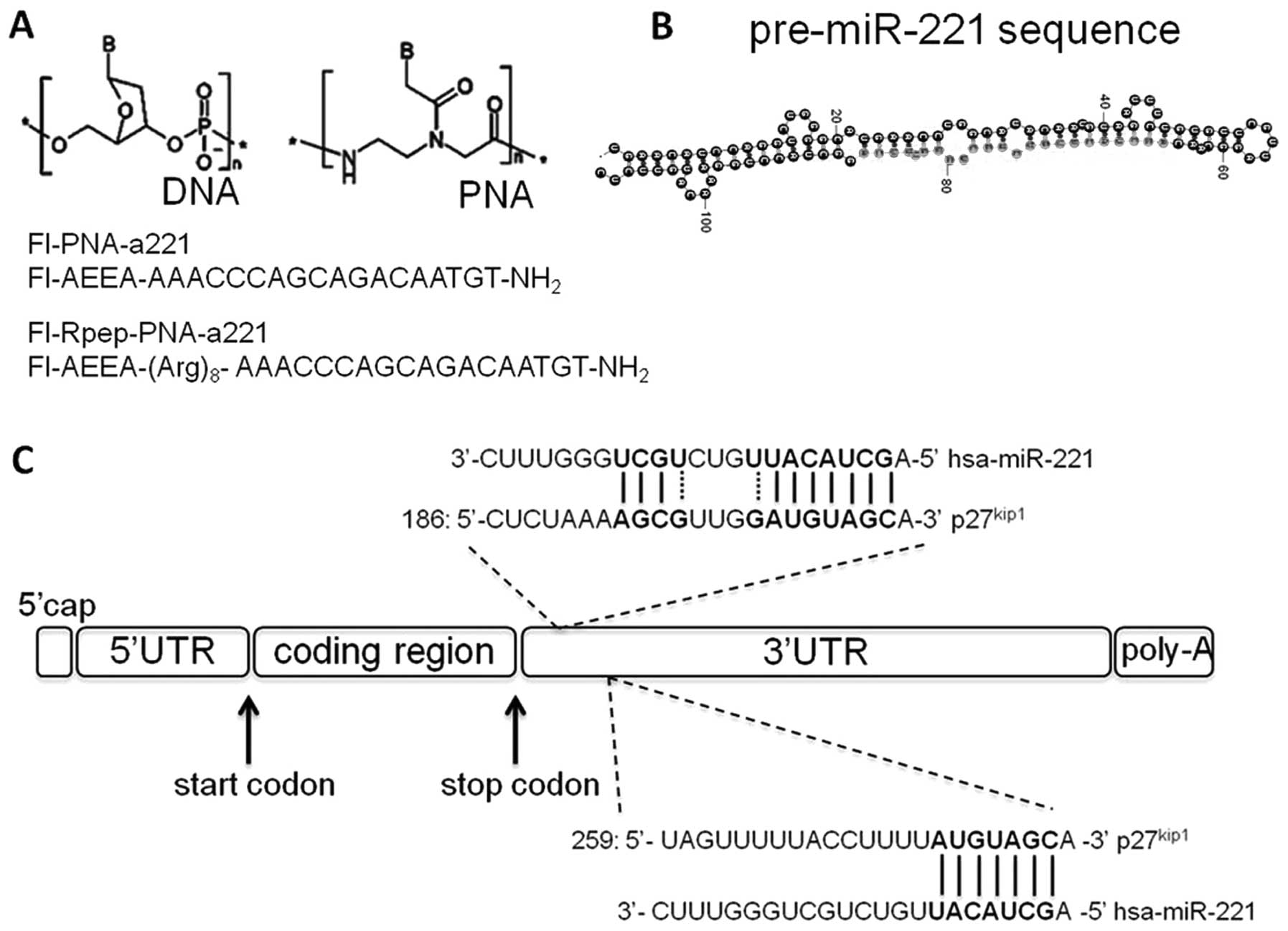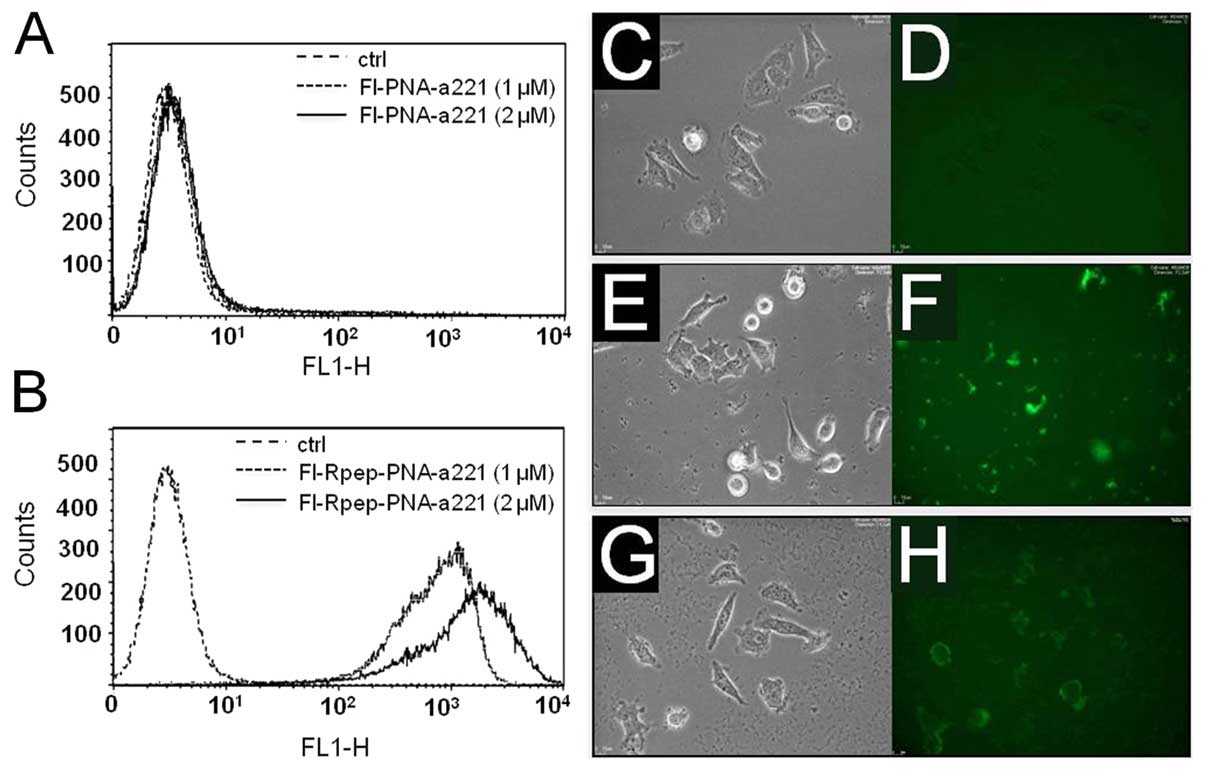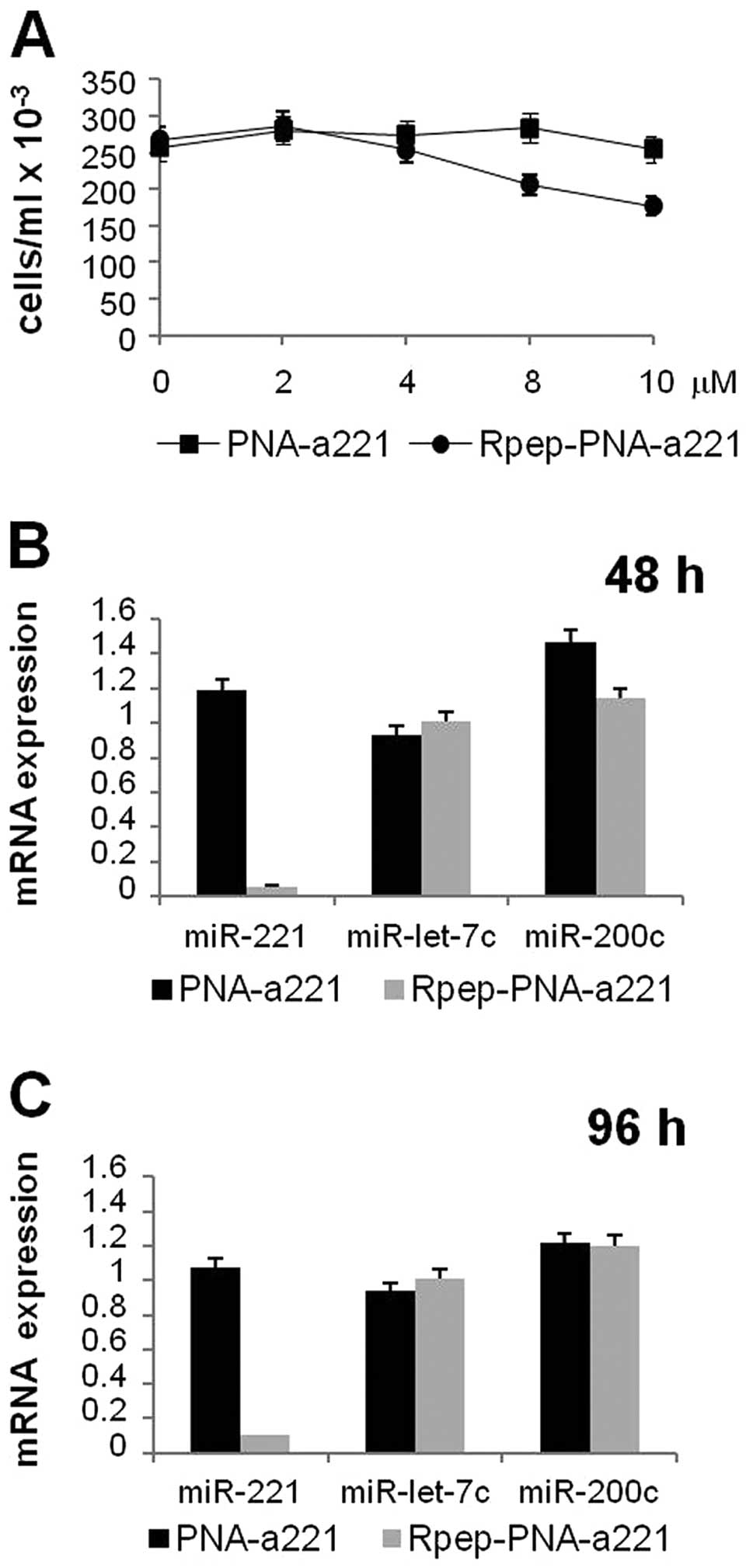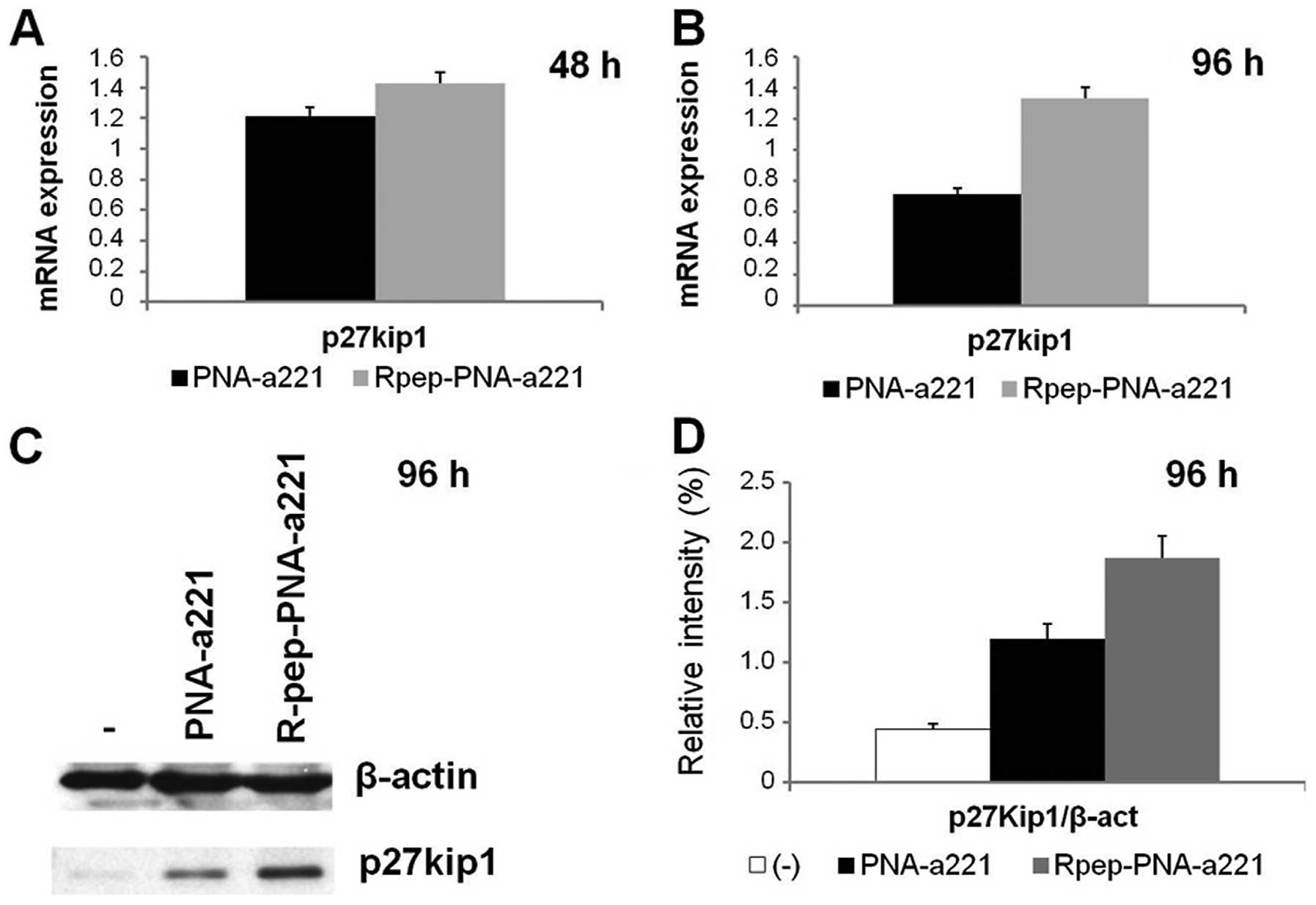|
1.
|
Filipowicz W, Jaskiewicz L, Kolb FA and
Pillai RS: Post-transcriptional gene silencing by siRNAs and
miRNAs. Curr Opin Struct Biol. 15:331–341. 2005. View Article : Google Scholar : PubMed/NCBI
|
|
2.
|
He L and Hannon GJ: MicroRNAs: small RNAs
with a big role in gene regulation. Nat Rev Genet. 5:522–531. 2010.
View Article : Google Scholar : PubMed/NCBI
|
|
3.
|
Kozomara A and Griffiths-Jones S: miRBase:
integrating microRNA annotation and deep-sequencing data. Nucleic
Acids Res. 39:D152–D157. 2011. View Article : Google Scholar : PubMed/NCBI
|
|
4.
|
Krol J, Loedige I and Filipowicz W: The
widespread regulation of microRNA biogenesis, function and decay.
Nat Rev Genet. 11:597–610. 2010.PubMed/NCBI
|
|
5.
|
Cho WCS: OncomiRs: the discovery and
progress of microRNAs in cancers. Mol Cancer. 6:602007. View Article : Google Scholar : PubMed/NCBI
|
|
6.
|
Edmonds MD, Hurst DR and Welch DR: Linking
metastasis suppression with metastamiR regulation. Cell Cycle.
17:2673–2675. 2009. View Article : Google Scholar : PubMed/NCBI
|
|
7.
|
Shah MY and Calin GA: MicroRNAs miR-221
and miR-222: a new level of regulation in aggressive breast cancer.
Genome Med. 3:56–68. 2011. View
Article : Google Scholar : PubMed/NCBI
|
|
8.
|
Zhang CZ, Zhang JX, Zhang AL, et al:
MiR-221 and miR-222 target PUMA to induce cell survival in
glioblastoma. Mol Cancer. 9:2292010. View Article : Google Scholar : PubMed/NCBI
|
|
9.
|
Fu X, Wang Q, Chen J, et al: Clinical
significance of miR-221 and its inverse correlation with
p27Kip1 in hepatocellular carcinoma. Mol Biol Rep.
38:3029–3035. 2011. View Article : Google Scholar : PubMed/NCBI
|
|
10.
|
Park JK, Lee EJ, Esau C and Schmittgen TD:
Antisense inhibition of microRNA-21 or -221 arrests cell cycle,
induces apoptosis, and sensitizes the effects of gemcitabine in
pancreatic adenocarcinoma. Pancreas. 38:e190–e199. 2009. View Article : Google Scholar : PubMed/NCBI
|
|
11.
|
Kanemaru H, Fukushima S, Yamashita J, et
al: The circulating microRNA-221 level in patients with malignant
melanoma as a new tumor marker. J Dermatol Sci. 3:187–193. 2011.
View Article : Google Scholar : PubMed/NCBI
|
|
12.
|
Frenquelli M, Muzio M, Scielzo C, et al:
MicroRNA and proliferation control in chronic lymphocytic leukemia:
functional relationship between miR-221/222 cluster and p27. Blood.
19:3949–3959. 2010. View Article : Google Scholar : PubMed/NCBI
|
|
13.
|
Visone R, Russo L, Pallante P, et al:
MicroRNAs (miR)-221 and miR-222, both overexpressed in human
thyroid papillary carcinomas, regulate p27Kip1 protein levels and
cell cycle. Endocr Relat Cancer. 14:791–798. 2007. View Article : Google Scholar : PubMed/NCBI
|
|
14.
|
Zheng C, Yinghao S and Li J: MiR-221
expression affects invasion potential of human prostate carcinoma
cell lines by targeting DVL2. Med Oncol. 29:815–822. 2012.
View Article : Google Scholar : PubMed/NCBI
|
|
15.
|
Zhang C, Zhang J, Zhang A, Wang Y, Han L,
You Y, Pu P and Kang C: PUMA is a novel target of miR-221/222 in
human epithelial cancers. Int J Oncol. 6:1621–1626. 2010.PubMed/NCBI
|
|
16.
|
Chun-Zhi Z, Lei H, An-Ling Z, et al:
MicroRNA-221 and microRNA-222 regulate gastric carcinoma cell
proliferation and radioresistance by targeting PTEN. BMC Cancer.
10:3672010. View Article : Google Scholar : PubMed/NCBI
|
|
17.
|
Lu X, Zhao P, Zhang C, et al: Analysis of
miR-221 and p27 expression in human gliomas. Mol Med Rep.
4:651–656. 2009.PubMed/NCBI
|
|
18.
|
Zhang C, Kang C, You Y, et al:
Co-suppression of miR-221/222 cluster suppresses human glioma cell
growth by targeting p27kip1 in vitro and in
vivo. Int J Oncol. 34:1653–1660. 2009.PubMed/NCBI
|
|
19.
|
Le Sage C, Nagel R, Egan DA, et al:
Regulation of the p27(Kip1) tumor suppressor by miR-221 and miR-222
promotes cancer cell proliferation. EMBO J. 26:3699–3708.
2007.PubMed/NCBI
|
|
20.
|
Galardi S, Mercatelli N, Giorda E,
Massalini S, Frajese GV, Ciafrè SA and Farace MG: miR-221 and
miR-222 expression affects the proliferation potential of human
prostate carcinoma cell lines by targeting p27Kip1. J Biol Chem.
282:23716–23724. 2007. View Article : Google Scholar : PubMed/NCBI
|
|
21.
|
Marin VL, Roy S and Armitage BA: Recent
advances in the development of peptide nucleic acid as a
gene-targeted drug. Expert Opin Biol Ther. 4:337–348. 2004.
View Article : Google Scholar : PubMed/NCBI
|
|
22.
|
Pession A, Tonelli R, Fronza R, et al:
Targeted inhibition of NMYC by peptide nucleic acid (PNA) in N-myc
amplified human neuroblastoma cells: cell-cycle inhibition with
induction of neuronal cell differentiation and apoptosis. Int J
Oncol. 24:265–272. 2004.PubMed/NCBI
|
|
23.
|
Gambari R: Biological activity and
delivery of peptide nucleic acids (PNA)-DNA chimeras for
transcription factor decoy (TFD) pharmacotherapy. Curr Med Chem.
11:1253–1263. 2004. View Article : Google Scholar : PubMed/NCBI
|
|
24.
|
Nielsen PE, Egholm M, Berg RH and Buchardt
O: Sequence-selective recognition of DNA by strand displacement
with a thymine-substituted polyamide. Science. 254:1497–1500. 1991.
View Article : Google Scholar : PubMed/NCBI
|
|
25.
|
Nastruzzi C, Cortesi R, Esposito E, et al:
Liposomes as carriers for DNA-PNA hybrids. J Control Release.
68:237–249. 2000. View Article : Google Scholar : PubMed/NCBI
|
|
26.
|
Paulasova P and Pellestor F: The peptide
nucleic acids (PNAs): a new generation of probes for genetic and
cytogenetic analyses. Ann Genet. 47:349–358. 2004. View Article : Google Scholar : PubMed/NCBI
|
|
27.
|
Karkare S and Bhatnagar D: Promising
nucleic acid analogs and mimics: characteristic features and
applications of PNA, LNA, and morpholino. Appl Microbiol
Biotechnol. 71:575–586. 2006. View Article : Google Scholar : PubMed/NCBI
|
|
28.
|
Menchise V, De Simone G, Tedeschi T, et
al: Insights into peptide nucleic acid (PNA) structural features:
the crystal structure of a D-lysine-based chiral PNA-DNA duplex.
Proc Natl Acad Sci USA. 100:12021–12026. 2003. View Article : Google Scholar : PubMed/NCBI
|
|
29.
|
Nielsen PE: Antisense peptide nucleic
acids. Curr Opin Mol Ther. 2:282–287. 2000.
|
|
30.
|
Soomets U, Hällbrink M and Langel U:
Antisense properties of peptide nucleic acids. Front Biosci.
4:D782–D786. 1999. View Article : Google Scholar : PubMed/NCBI
|
|
31.
|
Ray A and Nordén B: Peptide nucleic acid
(PNA): its medical and biotechnical applications and promise for
the future. FASEB J. 14:1041–1060. 2000.PubMed/NCBI
|
|
32.
|
Tonelli R, Purgato S, Camerin C, Fronza S,
et al: Anti-gene peptide nucleic acid specifically inhibits MYCN
expression in human neuroblastoma cells leading to persistent cell
growth inhibition and apoptosis. Mol Cancer Ther. 4:779–786. 2005.
View Article : Google Scholar : PubMed/NCBI
|
|
33.
|
Nielsen PE: Targeting double stranded DNA
with peptide nucleic acid (PNA). Curr Med Chem. 8:545–550. 2001.
View Article : Google Scholar : PubMed/NCBI
|
|
34.
|
Borgatti M, Lampronti I, Romanelli A, et
al: Transcription factor decoy molecules based on a peptide nucleic
acid (PNA)-DNA chimera mimicking Sp1 binding sites. J Biol Chem.
278:7500–7509. 2003. View Article : Google Scholar : PubMed/NCBI
|
|
35.
|
Rasmussen FW, Bendifallah N, Zachar V, et
al: Evaluation of transfection protocols for unmodified and
modified peptide nucleic acid (PNA) oligomers. Oligonucleotides.
16:43–57. 2006. View Article : Google Scholar : PubMed/NCBI
|
|
36.
|
Cortesi R, Mischiati C, Borgatti M, et al:
Formulations for natural and peptide nucleic acids based on
cationic polymeric submicron particles. AAPS J. 6:10–21. 2004.
|
|
37.
|
Borgatti M, Breda L, Cortesi R, et al:
Cationic liposomes as delivery systems for double-stranded PNA-DNA
chimeras exhibiting decoy activity against NF-kappaB transcription
factors. Biochem Pharmacol. 64:609–616. 2002. View Article : Google Scholar : PubMed/NCBI
|
|
38.
|
Abes R, Arzumanov A, Moulton H, et al:
Arginine-rich cell penetrating peptides: design, structureactivity,
and applications to alter pre-mRNA splicing by steric-block
oligonucleotides. J Pept Sci. 14:455–460. 2008. View Article : Google Scholar : PubMed/NCBI
|
|
39.
|
Torres AG, Threlfall RN and Gait MJ:
Potent and sustained cellular inhibition of miR-122 by
lysine-derivatized peptide nucleic acids (PNA) and phosphorothioate
locked nucleic acid (LNA)/2′-O-methyl (OMe) mixmer anti-miRs in the
absence of transfection agents. Artificial DNA PNA XNA. 2:71–78.
2011.PubMed/NCBI
|
|
40.
|
Fabani MM and Gait MJ: miR-122 targeting
with LNA/2′-O-methyl oligonucleotide mixmers, peptide nucleic acids
(PNA), and PNA-peptide conjugates. RNA. 14:336–346. 2008.
|
|
41.
|
Fabani MM, Abreu-Goodger C, Williams D, et
al: Efficient inhibition of miR-155 function in vivo by peptide
nucleic acids. Nucleic Acids Res. 38:4466–4475. 2010. View Article : Google Scholar : PubMed/NCBI
|
|
42.
|
Yan LX, Wu QN, Zhang Y, et al: Knockdown
of miR-21 in human breast cancer cell lines inhibits proliferation,
in vitro migration and in vivo tumor growth. Breast Cancer Res.
13:R22011. View Article : Google Scholar : PubMed/NCBI
|
|
43.
|
Bianchi N, Zuccato C, Lampronti I,
Borgatti M and Gambari R: Expression of miR-210 during erythroid
differentiation and induction of gamma-globin gene expression. BMB
Rep. 42:493–499. 2009. View Article : Google Scholar : PubMed/NCBI
|
|
44.
|
Fabbri E, Manicardi A, Tedeschi T, et al:
Modulation of the biological activity of microRNA-210 with peptide
nucleic acids (PNAs). Chem Med Chem. 6:2192–2202. 2011. View Article : Google Scholar : PubMed/NCBI
|
|
45.
|
Mizuma M, Katayose Y, Yamamoto K, et al:
Up-regulated p27Kip1 reduces matrix metalloproteinase-9 and
inhibits invasion of human breast cancer cells. Anticancer Res.
28(5A): 2669–2677. 2008.PubMed/NCBI
|
|
46.
|
Manicardi A, Calabretta A, Bencivenni M,
Tedeschi T, Sforza S, Corradini R and Marchelli R: Affinity and
selectivity of C2- and C5-substituted ‘chiral-box’ PNA in solution
and on microarrays. Chirality. 22(Suppl 1): E161–E172.
2010.PubMed/NCBI
|
|
47.
|
Cailleau R, Olivé M and Cruciger QV:
Long-term human breast carcinoma cell lines of metastatic origin:
preliminary characterization. In Vitro. 14:911–915. 1978.
View Article : Google Scholar : PubMed/NCBI
|
|
48.
|
Brown I, Shalli K, McDonald SL, Moir SE,
Hutcheon AW, Heys SD and Schofield AC: Reduced expression of p27 is
a novel mechanism of docetaxel resistance in breast cancer cells.
Breast Cancer Res. 6:R601–R607. 2004. View
Article : Google Scholar : PubMed/NCBI
|
|
49.
|
Faccini A, Tortori A, Tedeschi T, et al:
Circular dichroism study of DNA binding by a potential anticancer
peptide nucleic acid targeted against the MYCN oncogene. Chirality.
20:494–500. 2008. View Article : Google Scholar : PubMed/NCBI
|
|
50.
|
Suzuki T, Wu D, Schlachetzki F, Li JY,
Boado RJ and Pardridge WM: Imaging endogenous gene expression in
brain cancer in vivo with 111In-peptide nucleic acid antisense
radiopharmaceuticals and brain drug-targeting technology. J Nucl
Med. 45:1766–1775. 2004.PubMed/NCBI
|
|
51.
|
Pardridge WM, Boado RJ and Kang YS:
Vector-mediated delivery of a polyamide (‘peptide’) nucleic acid
analogue through the blood-brain barrier in vivo. Proc Natl Acad
Sci USA. 92:5592–5596. 1995.PubMed/NCBI
|
|
52.
|
Adlerz L, Soomets U, Holmlund L, Viirlaid
S, Langel U and Iverfeldt K: Down-regulation of amyloid precursor
protein by peptide nucleic acid oligomer in cultured rat primary
neurons and astrocytes. Neurosci Lett. 336:55–59. 2003. View Article : Google Scholar : PubMed/NCBI
|



